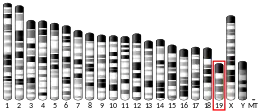DPP3
Dipeptidyl-peptidase 3 is an enzyme that in humans is encoded by the DPP3 gene.[5][6]
| DPP3 | |||||||||||||||||||||||||
|---|---|---|---|---|---|---|---|---|---|---|---|---|---|---|---|---|---|---|---|---|---|---|---|---|---|
| |||||||||||||||||||||||||
| Identifiers | |||||||||||||||||||||||||
| Aliases | DPP3, DPPIII, dipeptidyl peptidase 3 | ||||||||||||||||||||||||
| External IDs | OMIM: 606818 MGI: 1922471 HomoloGene: 40210 GeneCards: DPP3 | ||||||||||||||||||||||||
| |||||||||||||||||||||||||
| |||||||||||||||||||||||||
| |||||||||||||||||||||||||
| Orthologs | |||||||||||||||||||||||||
| Species | Human | Mouse | |||||||||||||||||||||||
| Entrez | |||||||||||||||||||||||||
| Ensembl | |||||||||||||||||||||||||
| UniProt | |||||||||||||||||||||||||
| RefSeq (mRNA) | |||||||||||||||||||||||||
| RefSeq (protein) | |||||||||||||||||||||||||
| Location (UCSC) | Chr 11: 66.48 – 66.51 Mb | Chr 19: 4.91 – 4.93 Mb | |||||||||||||||||||||||
| PubMed search | [3] | [4] | |||||||||||||||||||||||
| Wikidata | |||||||||||||||||||||||||
| |||||||||||||||||||||||||
This gene encodes a protein that is a member of the S9B family in clan SC of the serine proteases. This cytoplasmic protein binds a single zinc ion with its zinc-binding motif (HELLGH) and has post-proline dipeptidyl aminopeptidase activity, cleaving Xaa-Pro dipeptides from the N-termini of proteins. Increased activity of this protein is associated with endometrial and ovarian cancers. Alternate transcriptional splice variants have been characterized.[7]
References
- GRCh38: Ensembl release 89: ENSG00000254986 - Ensembl, May 2017
- GRCm38: Ensembl release 89: ENSMUSG00000063904 - Ensembl, May 2017
- "Human PubMed Reference:". National Center for Biotechnology Information, U.S. National Library of Medicine.
- "Mouse PubMed Reference:". National Center for Biotechnology Information, U.S. National Library of Medicine.
- Fukasawa KM, Fukasawa K, Harada M (Jun 2000). "Assignment of the dipeptidyl peptidase III gene (DPP3) to human chromosome 11 band q12→q13.1 by in situ hybridization". Cytogenet Cell Genet. 88 (1–2): 99–100. doi:10.1159/000015498. PMID 10773679. S2CID 202603.
- "DPP3 dipeptidyl peptidase 3 [Homo sapiens (human)] - Gene - NCBI". www.ncbi.nlm.nih.gov. Retrieved 2019-05-16.
- "DPP3 dipeptidyl peptidase 3 [Homo sapiens (human)] - Gene - NCBI". www.ncbi.nlm.nih.gov. Retrieved 2019-05-16.
Further reading
- Kar NC, Pearson CM (1978). "Dipeptidyl peptidases in human muscle disease". Clin. Chim. Acta. 82 (1–2): 185–92. doi:10.1016/0009-8981(78)90042-6. PMID 618680.
- Grdisa M, Vitale L (1991). "Types and localization of aminopeptidases in different human blood cells". Int. J. Biochem. 23 (3): 339–45. doi:10.1016/0020-711X(91)90116-5. PMID 2044841.
- Swanson AA, Davis RM, Meinhardt NC (1985). "Proteases in human lenses and their possible significance". Curr. Eye Res. 4 (1): 43–8. doi:10.3109/02713688508999965. PMID 2858361.
- Vanha-Perttula T (1989). "Dipeptidyl peptidase III and alanyl aminopeptidase in the human seminal plasma: origin and biochemical properties". Clin. Chim. Acta. 177 (2): 179–95. doi:10.1016/0009-8981(88)90140-4. PMID 2906822.
- Shimamori Y, Watanabe Y, Fujimoto Y (1989). "Human placental dipeptidyl aminopeptidase III: hydrolysis of enkephalins and its stimulation by cobaltous ion". Biochem. Med. Metab. Biol. 40 (3): 305–10. doi:10.1016/0885-4505(88)90133-8. PMID 3233187.
- Abramić M, Zubanović M, Vitale L (1988). "Dipeptidyl peptidase III from human erythrocytes". Biol. Chem. Hoppe-Seyler. 369 (1): 29–38. doi:10.1515/bchm3.1988.369.1.29. PMID 3348886.
- Shimamori Y, Watanabe Y, Fujimoto Y (1987). "Purification and characterization of dipeptidyl aminopeptidase III from human placenta". Chem. Pharm. Bull. 34 (8): 3333–40. doi:10.1248/cpb.34.3333. PMID 3791505.
- Swanson AA, Davis RM, McDonald JK (1984). "Dipeptidyl peptidase III of human cataractous lenses. Partial purification". Curr. Eye Res. 3 (2): 287–91. doi:10.3109/02713688408997211. PMID 6368131.
- Jones TH, Kapralou A (1982). "A rapid assay for dipeptidyl aminopeptidase III in human erythrocytes". Anal. Biochem. 119 (2): 418–23. doi:10.1016/0003-2697(82)90607-8. PMID 7041700.
- Vitale L, Zubanović M, Abramić M (1982). "Properties and distribution of aminopeptidase and dipeptidyl aminopeptidase III of human erythrocytes". Acta Biol. Med. Ger. 40 (10–11): 1489–95. PMID 7044004.
- Maruyama K, Sugano S (1994). "Oligo-capping: a simple method to replace the cap structure of eukaryotic mRNAs with oligoribonucleotides". Gene. 138 (1–2): 171–4. doi:10.1016/0378-1119(94)90802-8. PMID 8125298.
- Suzuki Y, Yoshitomo-Nakagawa K, Maruyama K, et al. (1997). "Construction and characterization of a full length-enriched and a 5'-end-enriched cDNA library". Gene. 200 (1–2): 149–56. doi:10.1016/S0378-1119(97)00411-3. PMID 9373149.
- Fukasawa K, Fukasawa KM, Kanai M, et al. (1998). "Dipeptidyl peptidase III is a zinc metallo-exopeptidase. Molecular cloning and expression". Biochem. J. 329 ( Pt 2) (Pt 2): 275–82. doi:10.1042/bj3290275. PMC 1219041. PMID 9425109.
- Simaga S, Babić D, Osmak M, et al. (1998). "Dipeptidyl peptidase III in malignant and non-malignant gynaecological tissue". Eur. J. Cancer. 34 (3): 399–405. doi:10.1016/S0959-8049(97)00401-2. PMID 9640230.
- Akiyama T, Harada S, Kojima F, et al. (1998). "Fluostatins A and B, new inhibitors of dipeptidyl peptidase III, produced by Streptomyces sp. TA-3391. I. Taxonomy of producing strain, production, isolation, physico-chemical properties and biological properties". J. Antibiot. 51 (6): 553–9. doi:10.7164/antibiotics.51.553. PMID 9711218.
- Fukasawa K, Fukasawa KM, Iwamoto H, et al. (1999). "The HELLGH motif of rat liver dipeptidyl peptidase III is involved in zinc coordination and the catalytic activity of the enzyme". Biochemistry. 38 (26): 8299–303. doi:10.1021/bi9904959. PMID 10387075.
- Hashimoto J, Yamamoto Y, Kurosawa H, et al. (2000). "Identification of dipeptidyl peptidase III in human neutrophils". Biochem. Biophys. Res. Commun. 273 (2): 393–7. doi:10.1006/bbrc.2000.2827. PMID 10873616.
- Abramić M, Schleuder D, Dolovcak L, et al. (2001). "Human and rat dipeptidyl peptidase III: biochemical and mass spectrometric arguments for similarities and differences". Biol. Chem. 381 (12): 1233–43. doi:10.1515/BC.2000.151. PMID 11209758. S2CID 22245963.
- Strausberg RL, Feingold EA, Grouse LH, et al. (2003). "Generation and initial analysis of more than 15,000 full-length human and mouse cDNA sequences". Proc. Natl. Acad. Sci. U.S.A. 99 (26): 16899–903. doi:10.1073/pnas.242603899. PMC 139241. PMID 12477932.
External links
- DPP3 human gene location in the UCSC Genome Browser.
- DPP3 human gene details in the UCSC Genome Browser.
This article is issued from Wikipedia. The text is licensed under Creative Commons - Attribution - Sharealike. Additional terms may apply for the media files.



